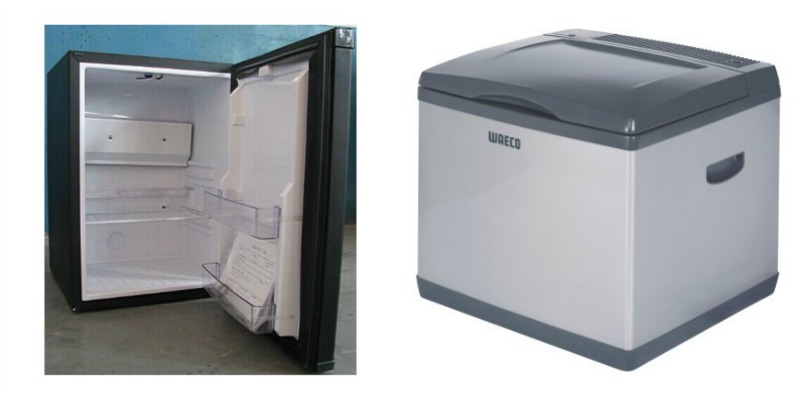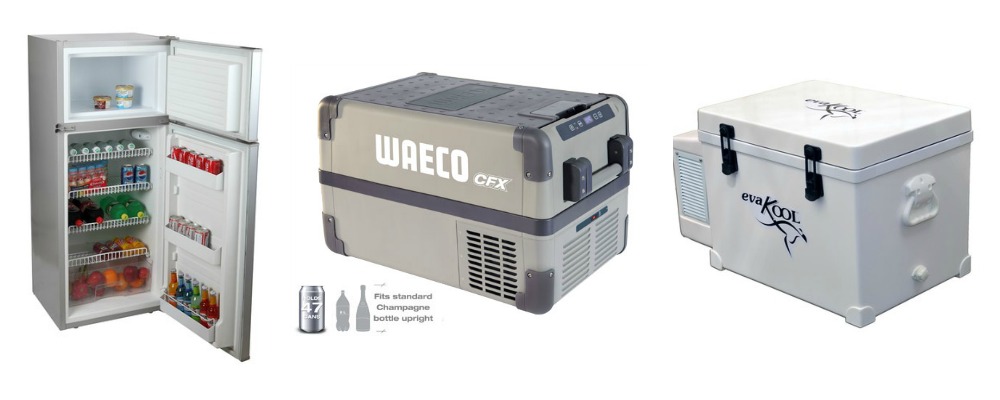4 Types of Replacements for RV Refrigerators
This post may contain affiliate links. See our privacy policy for details.
One of those areas that has always had my eyes glazing over (other than RV toilets) is RV Refrigerators. Why are they so confusing to shop for?
Two-way? Three-way? Compression? Portable coolers?
It will make your head spin!
Let’s dive into the types of RV refrigerators and your best options.
Four Different Types of Refrigeration
1. Absorption / 3-Way Refrigerator
An absorption refrigerator uses a gas flow heat exchange system which can be powered three different ways:
- 110/240v (being plugged into the campground power),
- 12v/24v (using power from your car or secondary battery) or
- Gas (LPG/propane)

Benefits of the Absorption Refrigerator
- Since they have no moving parts they are quiet
- Long lasting. When looked after these could last 20 years before needing to be replaced
- Very efficient on gas usage
- Newer fridges are clever enough to switch between the different power sources automatically
- Good for of-grid camping as you have three power sources and the gas lasts well
Limitations of the Absorption Refrigerator
- Must be level when operating
- Must be properly ventilated
- Are not as efficient as compressor fridges, when using 12v (battery) power
- Struggle to get cold when the ambient temperature is high
2. Compressor / 2-Way Refrigerator
The compressor refrigerator works in much the same way as your fridge at home but RV refrigerators are designed to be run on either:
- 110/240v (being plugged into the campground power),
- 12v /24v (using power from your car or secondary battery)
If you want to know more of the nitty gritty of how a compressor fridge works, then this short article and diagram here might be useful for you.
Compressor refrigerators come as regular (side) door opening fridges or chest type that have a top opening lid. The good thing about the chest type is that the cool air mostly stays in the fridge when you open it whereas the cold air comes rushing out the bottom of the refrigerator in the door opening type.

Benefits of a Compressor Refrigerator
- Efficient power usage when on 12v battery power
- Come in heaps of different sizes
- Can be dual zone (fridge and freezer) or single zone (either fridge or freezer)
- Good for use in really hot climates
Limitations of a Compressor Refrigerator
- Expensive!
- They have a motor in them so they are not silent
3. Thermoelectric Cooler
A thermoelectric cooler uses the “Peltier effect” which means:
“Thermoelectric cooling uses the Peltier effect to create a heat flux between the junction of two different types of materials. A Peltier cooler, heater, or thermoelectric heat pump is a solid-state active heat pump which transfers heat from one side of the device to the other, with consumption of electrical energy, depending on the direction of the current.” – Wikipedia

Like the absorption and compressor refrigerators they can be run on:
- 110/240V (being plugged into the campground power),
- 12V/24V (using power from your car or secondary battery)
But they are heavy consumers of battery power so would not be good for camping off-grid for very long.
Benefits of the Thermoelectric Cooler
- Inexpensive
- Reliable and long lasting – since they have no moving parts they continue to work well for many years
Limitations of the Thermoelectric Cooler
- Can only cool up to 20°C (70°F) below the ambient temperature (so not particularly useful in really hot climates)
- Uses a lot of battery power
- Only comes in small sizes
Thermoelectric coolers are a perfect fridge truck drivers, picnics and short camping trips. But they can’t be relied on for longer trips where you’re not driving a lot or don’t have access to mains power.
4. Cooler / Icebox / Chilly Bin / Esky
This is the cheapest and most common way of keeping food cool. I’m sure it doesn’t need any explanation from me about how these work. Put some ice, ice packs, frozen water bottles or other icey items in the chilly bin and they’ll help to keep everything else in there (like milk, cheese, vegetables) cool. Even though they’re well insulated, the ice will of course melt, and then the food will start warming up.

Benefits of the Cooler / Icebox / Chilly Bin / Esky
- Cheap!
- Don’t require a power source
Limitations of the Cooler / Icebox / Chilly Bin / Esky
- Need to find ice regularly
- No temperature control (except by putting in more or less ice)
- Water EVERYWHERE as the ice melts making everything soggy and annoying
For our trip around Australia, I think our best option would be a compressor refrigerator, but because of the cost of these fridges (and the associated battery and solar set-up we’ll need) I’m seriously considering just starting out with one of the good quality, well insulated iceboxes and seeing how we go.
What type of RV refrigerator do you have, and are you happy with it?
I love RVing! I share about our journey around Australia, how we came to do this trip, all the planning involved, and snapshots of what life on the road is like.







